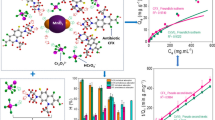Abstract
The thermodynamic stability constants for the hydrolysis and formation of mercury (Hg2+) chloride complexes
have been used to calculate the activity coefficients for Hg(OH) (2–n)+ n and HgCl (2–n)+ n complexes using the Pitzer specific interaction model. These values have been used to determine the Pitzer parameters for the hydroxide and chloro complexes \((\beta_{\rm ML}^{(0)}, \,\beta_{\rm ML}^{(1)}\) and C ML). The values of \(\lambda_{ij}\) and \(\zeta_{ijk}\) have been determined for the neutral complexes (Hg(OH)2 and HgCl2). The resultant parameters yield calculated values for the measured values of log \(\beta^{\ast}\) to ±0.01 from I = 0.1 to 3 m at 25°C. Since the activity coefficients of \(\hbox{Hg(OH)}_n^{(2-n)+}\) and \(\hbox{HgCl}_n^{(2-n)+}\) are in reasonable agreement with the values for Pb(II), we have estimated the effect of temperature on the chloride constants for Hg(II) from 0 to 300°C and I = 0–6 m using the Pitzer parameters for \(\hbox{PbCl}_n^{(2-n)+}\) complexes. The resulting parameters can be used to examine the speciation of Hg(II) with Cl− in natural waters over a wide range of conditions.





Similar content being viewed by others
References
Baes CF Jr, Mesmer RE (1976) The hydrolysis of cations. Wiley-Interscience, New-York
Benoit JM, Gilmour CC, Mason RP, Heyes A (1999) Sulfide controls on mercury speciation and bioavailability to methylating bacteria in sediment pore waters. Environ Sci Technol 33:951–957
Ciavatta L, Grimaldi M (1968) The hydrolysis of mercury(II) chloride, HgCl2. J Inorg Nucl Chem 30:563–581
Fitzgerald WF, Lamborg CH, Hammerschmidt CR (2007) Marine biogeochemical cycling of mercury. Chem Rev 107:641–662
Grenthe I, Plyasunov AV, Spahiu K (1997) Estimations of medium effects on thermodynamic data. In: Grenthe I, Puigdomenech I (eds) Modelling in aqueous chemistry. Organization for Economic Cooperation and Development, Paris, pp 325–426
Lamborg CH, Tseng CM, Fitzgerald WF, Balcom PH, Hammerschmidt CR (2003) Determination of the mercury complexation characteristics of dissolved organic matter in natural waters with "reducible Hg" titrations. Environ Sci Technol 37:3316–3322
Luo Y, Millero FJ (2007) Stability constant for the formation of lead chloride complexes as a function of temperature and ionic strength. Geochim Cosmochim Acta 71:326–334
Millero FJ, Pierrot D (2002) Speciation of metals in natural waters. In: Gianguzza A, Pellizzetti E, Sammartano S (eds) Chemistry of marine water and sediments. Springer-Verlag, Berlin, pp 193–220
Møller N (1988) The prediction of mineral solubilities in natural waters: a chemical equilibrium model for the Na–Ca–Cl–SO4–H2O system, to high temperature and concentration. Geochim Cosmochim Acta 52:821–837
Pitzer KS (1979) Theory: ion interaction approach. In: Pytkowicz RM (ed) Activity coefficients in electrolyte solutions, vol I. CRC Press, Boca Raton, pp 157–208
Pitzer KS (1991) Ion interaction approach: theory and data correlation. In: Pitzer KS (ed) Activity coefficients in electrolyte solutions, 2nd ed. CRC Press, Boca Raton, pp 75–153
Powell KJ, Brown PL, Byrne RH, Gajda T, Glenn H, Staffan S, Wanner H (2005) Chemical speciation of environmentally significant heavy metals with inorganic ligands. Part 1: the Hg2+-Cl−, OH−, CO 2−3 , SO 2−4 , and PO 3−4 aqueous systems. Pure Appl Chem 77:739–800
Seward TM (1984) The formation of lead (II) chloride complexes to 300°C: a spectrophotometric study. Geochim Cosmochim Acta 48:121–134
Von Burg R, Greenwood MR (1991) Mercury. In: Merian E (ed) Metals and their compounds in the environment: occurrence, analysis, and biological relevance. VCH, Weinheim, pp 1045–1088
Acknowledgements
We acknowledge the support of the Oceanographic Section of the National Science Foundation, the National Oceanic and Atmospheric Administration and the Spanish Ministerio de Educacion y Ciencia project CTM2006-09857. MGD wishes to acknowledge the support of the Ministerio de Educacion y Ciencia (PR2007-0163) for his stay in the USA. JMSC acknowledges the support of the Canary Islands Government for her stay in the USA.
Author information
Authors and Affiliations
Corresponding author
Rights and permissions
About this article
Cite this article
González-Dávila, M., Santana-Casiano, J.M. & Millero, F.J. Use of Pitzer Equations to Examine the Formation of Mercury(II) Hydroxide and Chloride Complexes in NaClO4 Media. Aquat Geochem 13, 339–355 (2007). https://doi.org/10.1007/s10498-007-9023-y
Received:
Accepted:
Published:
Issue Date:
DOI: https://doi.org/10.1007/s10498-007-9023-y




